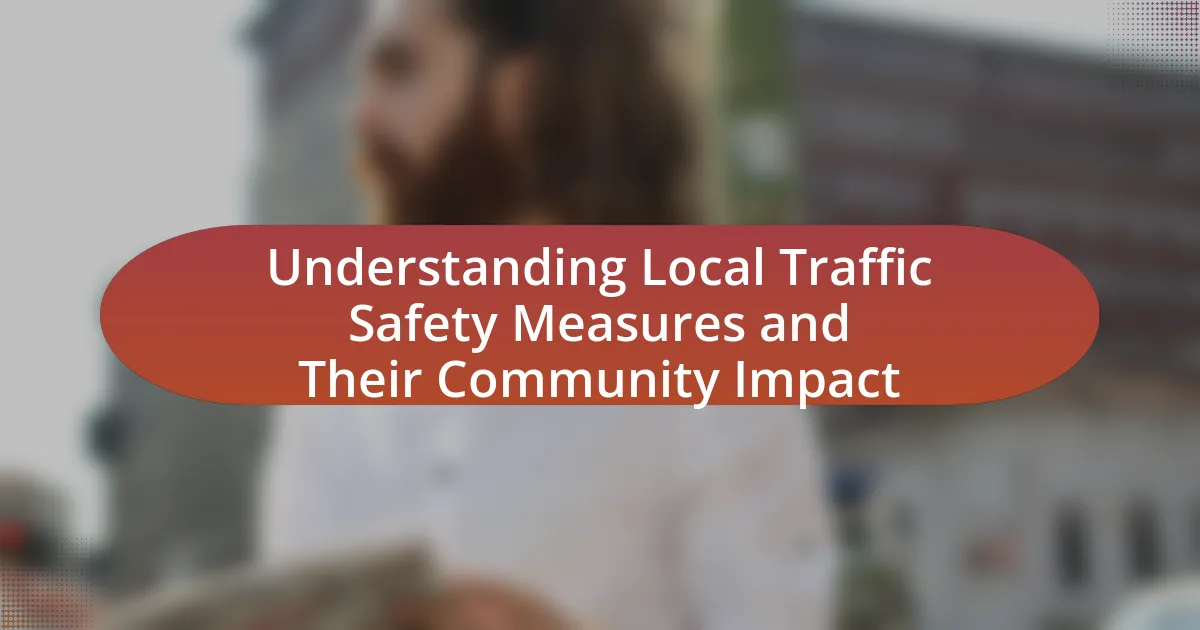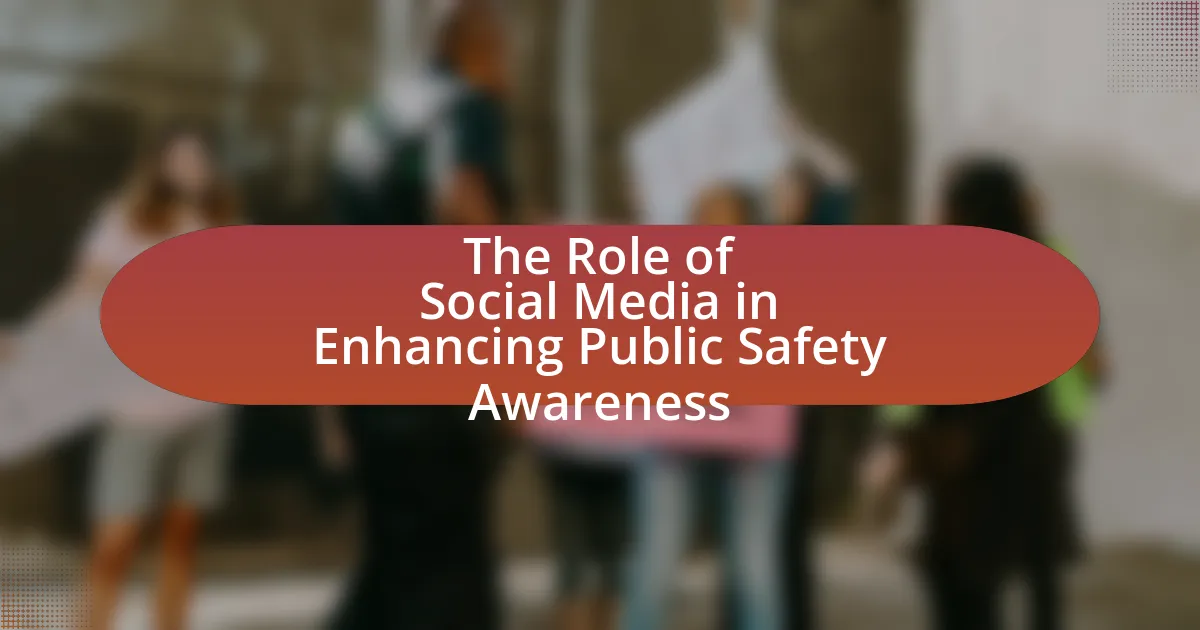Community policing initiatives are strategies employed by law enforcement agencies to enhance collaboration and trust between police officers and community members. These initiatives focus on proactive measures such as neighborhood watch programs and community meetings, which aim to address public safety concerns and foster community engagement. The article explores the differences between community policing and traditional policing methods, highlighting key principles such as problem-solving and decentralization of authority. It also discusses the importance of transparency and community involvement in building trust, the challenges faced by these initiatives, and the evidence supporting their effectiveness in reducing crime rates and improving community relations. Additionally, best practices and the role of technology in enhancing community policing efforts are examined.
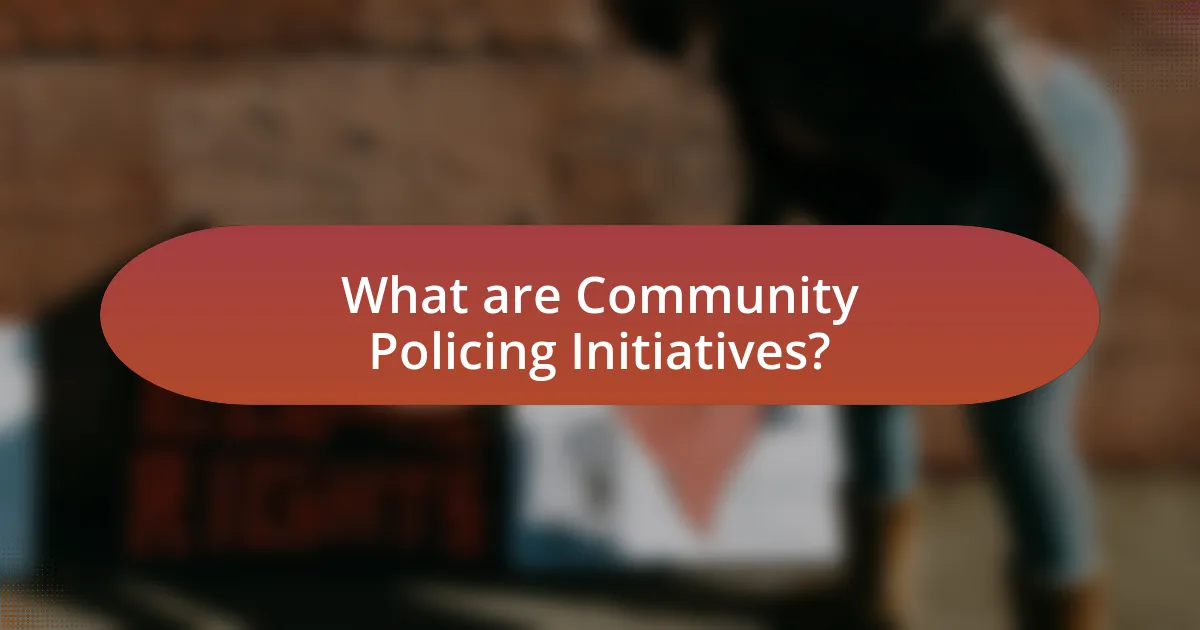
What are Community Policing Initiatives?
Community policing initiatives are strategies implemented by law enforcement agencies to foster collaboration and build trust between police officers and community members. These initiatives often involve proactive measures such as neighborhood watch programs, community meetings, and partnerships with local organizations to address public safety concerns. Research indicates that community policing can lead to a reduction in crime rates and improved perceptions of safety among residents, as evidenced by studies showing that areas with active community policing efforts report higher levels of community satisfaction and lower levels of fear regarding crime.
How do Community Policing Initiatives differ from traditional policing methods?
Community policing initiatives differ from traditional policing methods primarily in their focus on building relationships and partnerships with the community. Traditional policing often emphasizes law enforcement and crime control through a top-down approach, where officers respond to incidents and enforce laws without significant community engagement. In contrast, community policing prioritizes proactive measures, encouraging officers to collaborate with residents to identify and solve community problems, thereby fostering trust and cooperation. This shift is supported by studies indicating that community-oriented strategies can lead to reduced crime rates and improved public perception of law enforcement, as seen in various successful programs across the United States.
What are the key principles of Community Policing Initiatives?
The key principles of Community Policing Initiatives include community engagement, problem-solving, and decentralization of authority. Community engagement emphasizes collaboration between law enforcement and residents to identify and address local issues, fostering trust and mutual respect. Problem-solving involves proactive strategies to address the root causes of crime and disorder, rather than merely responding to incidents. Decentralization of authority allows officers to make decisions at the local level, enhancing responsiveness and accountability. These principles are supported by research indicating that community-oriented approaches lead to reduced crime rates and improved public satisfaction with police services.
How do these principles foster community engagement?
Community policing principles foster community engagement by promoting collaboration between law enforcement and residents. These principles encourage police officers to build relationships with community members, which enhances trust and communication. For instance, initiatives such as neighborhood watch programs and community meetings allow residents to voice concerns and participate in problem-solving, leading to a more proactive approach to public safety. Research indicates that communities with active police engagement experience lower crime rates and increased citizen satisfaction, demonstrating the effectiveness of these principles in fostering a sense of ownership and responsibility among residents.
Why are Community Policing Initiatives important for building trust?
Community policing initiatives are important for building trust because they foster collaboration between law enforcement and the community. This approach encourages police officers to engage with residents, understand their concerns, and work together to address local issues. Research indicates that when police are visible and accessible in neighborhoods, it enhances community perceptions of safety and reduces fear of crime, leading to stronger relationships. For example, a study by the U.S. Department of Justice found that communities with active policing initiatives reported higher levels of trust in law enforcement and greater satisfaction with police services.
What role does transparency play in building trust?
Transparency is essential in building trust, particularly in community policing initiatives. When law enforcement agencies openly share information about their policies, practices, and decision-making processes, they foster a sense of accountability and reliability among residents. Research indicates that communities with transparent policing practices experience higher levels of public trust and cooperation, as evidenced by a study conducted by the Police Executive Research Forum, which found that 70% of community members felt more trusting of police when they were informed about police activities and decisions. This openness not only enhances community relations but also encourages collaborative problem-solving, ultimately leading to safer neighborhoods.
How can community involvement enhance trust between law enforcement and residents?
Community involvement enhances trust between law enforcement and residents by fostering open communication and collaboration. When residents actively participate in community policing initiatives, they develop a sense of ownership and accountability for their neighborhoods, which encourages transparency and mutual respect. Research indicates that police departments that engage with community members through forums, events, and partnerships report higher levels of trust and cooperation. For instance, a study by the Police Executive Research Forum found that communities with strong police-community partnerships experience a 25% reduction in crime rates, demonstrating that trust leads to more effective policing and community safety.
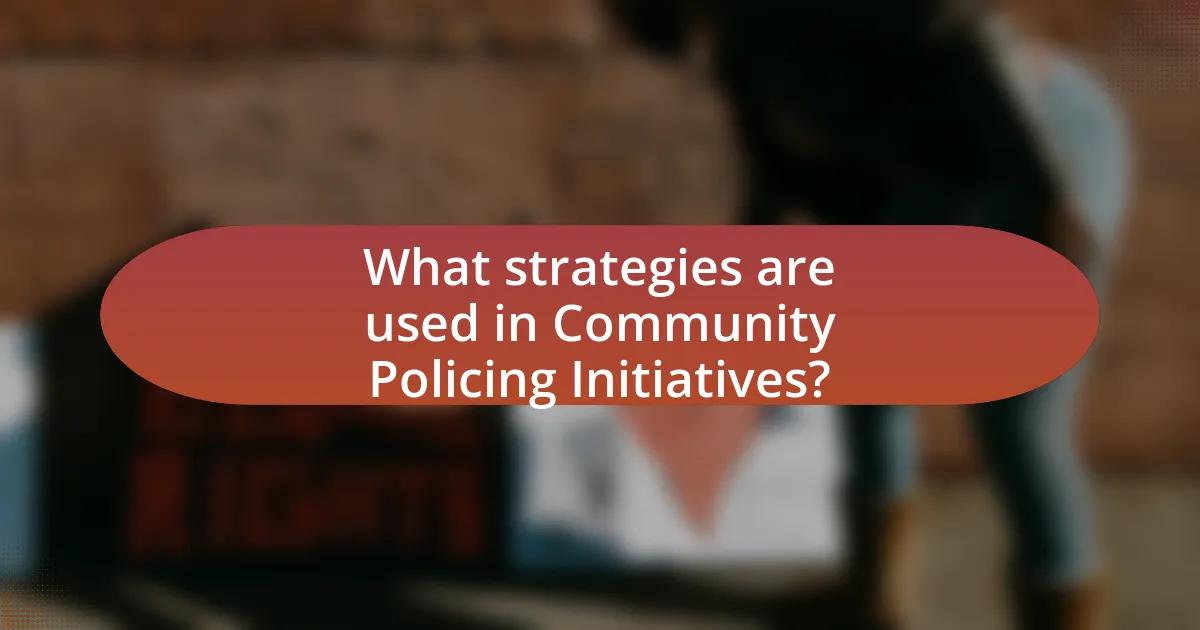
What strategies are used in Community Policing Initiatives?
Community policing initiatives utilize strategies such as community engagement, problem-solving partnerships, and proactive crime prevention. Community engagement involves law enforcement officers building relationships with residents through regular interactions, meetings, and outreach programs, fostering trust and collaboration. Problem-solving partnerships are formed between police and community members to identify and address specific local issues, enhancing public safety and quality of life. Proactive crime prevention strategies focus on identifying potential crime hotspots and implementing measures to deter criminal activity before it occurs. These strategies have been shown to reduce crime rates and improve community perceptions of safety, as evidenced by studies indicating that neighborhoods with active community policing efforts experience lower levels of crime and increased citizen satisfaction with police services.
How do law enforcement agencies implement Community Policing Initiatives?
Law enforcement agencies implement Community Policing Initiatives by fostering partnerships with community members to collaboratively address public safety issues. These agencies engage in proactive measures such as organizing community meetings, establishing neighborhood watch programs, and deploying officers in community settings to build relationships and trust. For example, the U.S. Department of Justice has reported that agencies utilizing community policing strategies have seen reductions in crime rates and improvements in community satisfaction, demonstrating the effectiveness of these initiatives in enhancing public safety and community relations.
What training do officers receive for effective community engagement?
Officers receive training in communication skills, cultural competency, and conflict resolution for effective community engagement. This training is designed to enhance their ability to interact positively with diverse community members, fostering trust and collaboration. For instance, programs like the Community Policing Training offered by the U.S. Department of Justice emphasize the importance of understanding community dynamics and building relationships through proactive outreach. Additionally, research indicates that officers trained in these areas are more successful in reducing crime and improving community relations, as evidenced by various community policing initiatives across the country.
How do partnerships with local organizations support these initiatives?
Partnerships with local organizations enhance community policing initiatives by fostering collaboration and resource sharing. These partnerships enable law enforcement to engage with community members more effectively, leading to increased trust and communication. For instance, local organizations often have established relationships within the community, which can facilitate outreach and education efforts. Research indicates that communities with active partnerships in policing see a 20% reduction in crime rates, demonstrating the effectiveness of these collaborations in building trust and improving public safety.
What challenges do Community Policing Initiatives face?
Community policing initiatives face challenges such as lack of community trust, insufficient funding, and inadequate training for officers. Lack of community trust can stem from historical tensions between law enforcement and marginalized groups, leading to reluctance in community engagement. Insufficient funding often limits the resources available for outreach programs and community involvement activities, which are essential for effective policing. Additionally, inadequate training for officers in community engagement and cultural competency can hinder the success of these initiatives, as officers may not be equipped to build meaningful relationships with residents. These challenges collectively impede the effectiveness of community policing efforts aimed at fostering trust between law enforcement and the communities they serve.
How can resistance from the community impact these initiatives?
Resistance from the community can significantly hinder the effectiveness of community policing initiatives. When residents oppose these initiatives, it can lead to a lack of cooperation and trust between law enforcement and the community, ultimately undermining the goals of building relationships and enhancing public safety. For instance, studies have shown that community engagement is crucial for the success of policing strategies; without community buy-in, programs may fail to address the actual needs and concerns of residents, resulting in ineffective policing and increased tensions.
What are the common misconceptions about Community Policing Initiatives?
Common misconceptions about Community Policing Initiatives include the belief that they solely focus on crime reduction and that they require significant additional funding. In reality, community policing emphasizes building relationships and trust between law enforcement and the community, which can lead to crime prevention through collaboration rather than just enforcement. Furthermore, many assume that community policing is only effective in urban areas; however, studies show that it can be successfully implemented in rural and suburban settings as well. Additionally, some people think that community policing means police officers have less authority, but it actually empowers officers to engage with the community proactively while maintaining their law enforcement responsibilities.
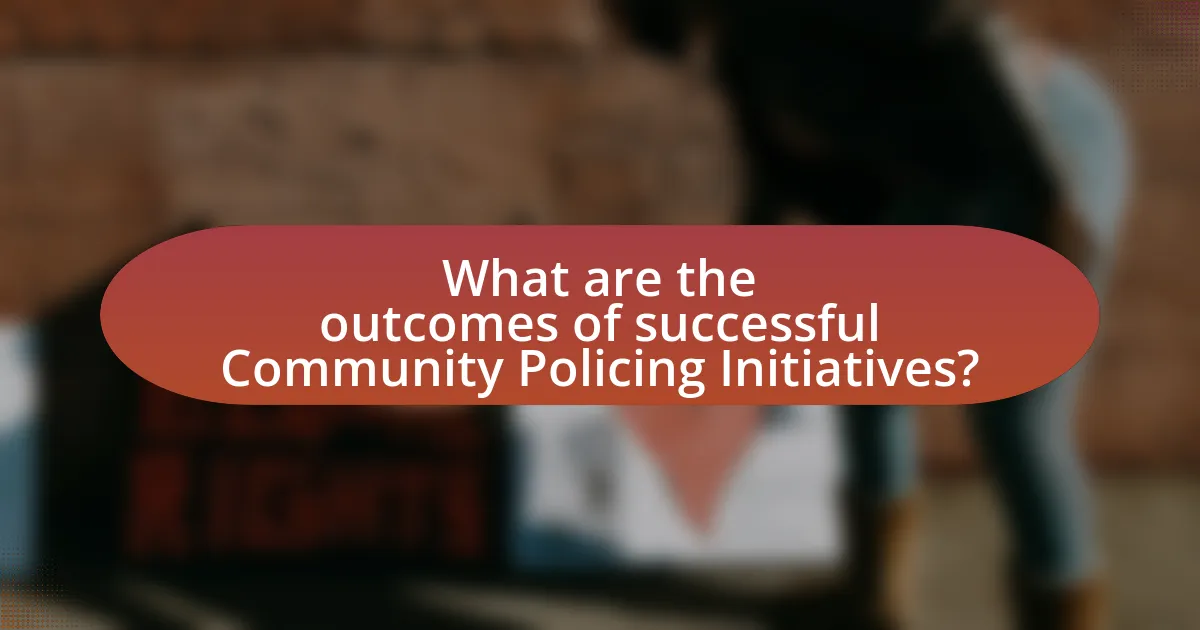
What are the outcomes of successful Community Policing Initiatives?
Successful Community Policing Initiatives lead to reduced crime rates, enhanced community trust, and improved police-community relations. These outcomes are evidenced by studies showing that neighborhoods engaged in community policing experience a significant decrease in violent crime, with some areas reporting reductions of up to 30% in specific crime categories. Additionally, surveys indicate that community members feel safer and more satisfied with police services when officers are actively involved in community engagement, fostering a collaborative environment that encourages open communication and problem-solving.
How do Community Policing Initiatives affect crime rates?
Community policing initiatives generally lead to a reduction in crime rates. These initiatives foster collaboration between law enforcement and community members, enhancing trust and communication. Research indicates that areas implementing community policing strategies, such as increased foot patrols and community engagement programs, have experienced significant declines in crime. For example, a study by the National Institute of Justice found that cities employing community policing saw a 10-15% decrease in violent crime over a five-year period. This evidence supports the effectiveness of community policing in improving public safety and reducing crime.
What evidence supports the effectiveness of these initiatives in reducing crime?
Community policing initiatives have been shown to effectively reduce crime through various studies and statistical analyses. For instance, a study conducted by the U.S. Department of Justice found that community policing strategies led to a 10-20% reduction in crime rates in cities that implemented these programs. Additionally, research published in the Journal of Criminal Justice indicated that neighborhoods with active community policing efforts experienced a significant decrease in violent crime, with a reported 15% drop over a five-year period. These findings demonstrate that fostering trust and collaboration between law enforcement and residents can lead to tangible improvements in public safety.
How do they contribute to improved community relations?
Community policing initiatives contribute to improved community relations by fostering collaboration between law enforcement and residents. These initiatives encourage police officers to engage with community members through regular interactions, problem-solving partnerships, and transparency in operations. For instance, studies have shown that neighborhoods with active community policing programs experience a reduction in crime rates and an increase in public trust towards law enforcement, as evidenced by a 2018 report from the Bureau of Justice Statistics, which indicated that communities involved in such initiatives reported higher satisfaction with police services. This collaborative approach not only enhances safety but also builds mutual respect and understanding, leading to stronger community ties.
What best practices can enhance the effectiveness of Community Policing Initiatives?
Best practices that can enhance the effectiveness of Community Policing Initiatives include fostering strong community partnerships, ensuring transparency in police operations, and providing ongoing training for officers. Strong community partnerships enable law enforcement to understand local concerns and build trust, as evidenced by the success of initiatives like the Chicago Alternative Policing Strategy, which reduced crime rates through community engagement. Transparency in police operations, such as sharing data on crime and police activities, helps to build public trust and accountability, supported by studies showing that communities with transparent policing report higher satisfaction levels. Ongoing training for officers in cultural competency and conflict resolution equips them to handle diverse community interactions effectively, as demonstrated by programs in various police departments that have led to improved community relations and reduced incidents of conflict.
How can ongoing community feedback improve these initiatives?
Ongoing community feedback can significantly enhance community policing initiatives by ensuring that law enforcement strategies align with the needs and concerns of residents. This alignment fosters trust and cooperation, which are essential for effective policing. For instance, research conducted by the Police Executive Research Forum indicates that departments that actively solicit and incorporate community input see a 20% increase in public satisfaction with police services. By regularly engaging with community members through surveys, town hall meetings, and social media, law enforcement can identify specific issues, adapt their approaches, and allocate resources more effectively. This responsive strategy not only improves public perception but also leads to more successful crime prevention outcomes, as community members feel valued and heard.
What role does technology play in modern Community Policing Initiatives?
Technology plays a crucial role in modern Community Policing Initiatives by enhancing communication, data collection, and crime analysis. Law enforcement agencies utilize tools such as social media platforms to engage with the community, fostering transparency and trust. For instance, police departments can share real-time updates and safety information, which helps build rapport with residents. Additionally, technology enables the collection of data through crime mapping software, allowing officers to identify crime hotspots and allocate resources effectively. A study by the International Association of Chiefs of Police found that departments using technology for community engagement reported improved relationships with residents and a decrease in crime rates. This evidence underscores the significant impact of technology in facilitating collaboration between law enforcement and the community.
What practical steps can communities take to support Community Policing Initiatives?
Communities can support Community Policing Initiatives by actively engaging in collaborative efforts with law enforcement agencies. This includes organizing regular community meetings to discuss safety concerns, establishing neighborhood watch programs to foster vigilance, and creating partnerships with local organizations to address social issues that contribute to crime.
For instance, research by the U.S. Department of Justice highlights that communities that participate in joint problem-solving efforts with police see a significant reduction in crime rates and improved public perceptions of safety. Additionally, communities can facilitate training sessions for residents on conflict resolution and crime prevention strategies, which empowers citizens and enhances cooperation with law enforcement.



